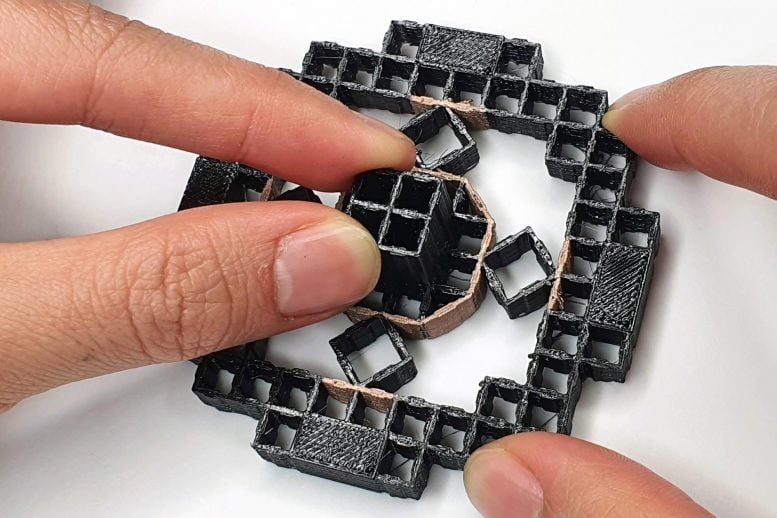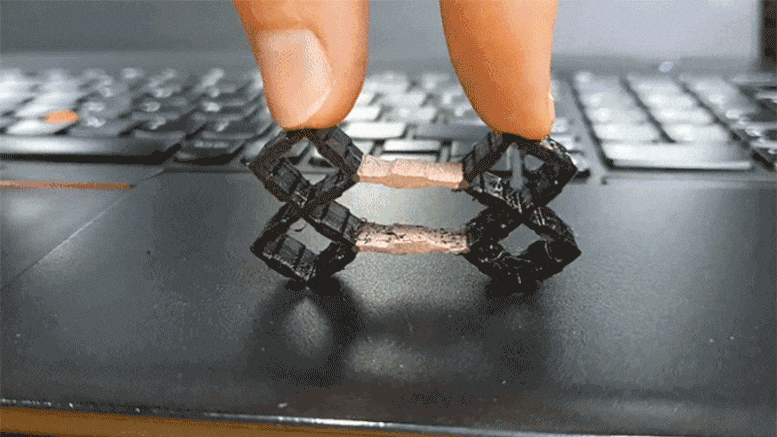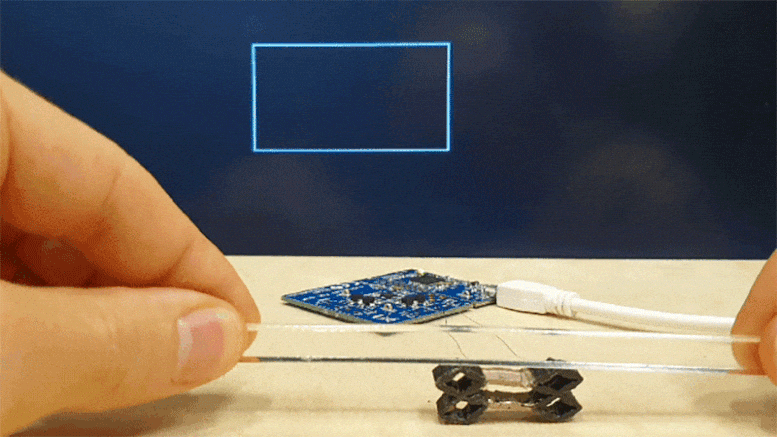
Researchers from MIT have developed a method to integrate sensing capabilities into 3D printable structures comprised of repetitive cells, which enables designers to rapidly prototype interactive input devices. Credit: Courtesy of the researchers
Advance incorporates sensing directly into an object’s material, with applications for assistive technology and “intelligent” furniture.
“
Embedded electrodes
Because metamaterials are made from a grid of cells, when the user applies force to a metamaterial object, some of the flexible, interior cells stretch or compress.
The researchers took advantage of this by creating “conductive shear cells,” flexible cells that have two opposing walls made from conductive filament and two walls made from nonconductive filament. The conductive walls function as electrodes.
When a user applies force to the metamaterial mechanism — moving a joystick handle or pressing the buttons on a controller — the conductive shear cells stretch or compress, and the distance and overlapping area between the opposing electrodes changes. Using capacitive sensing, those changes can be measured and used to calculate the magnitude and direction of the applied forces, as well as rotation and acceleration.
To demonstrate this, the researchers created a metamaterial joystick with four conductive shear cells embedded around the base of the handle in each direction (up, down, left, and right). As the user moves the joystick handle, the distance and area between the opposing conductive walls changes, so the direction and magnitude of each applied force can be sensed. In this case, those values were converted to inputs for a “PAC-MAN” game.

This flexible input device has been 3D printed in one piece with copper-colored sensing electrodes integrated into its structure. Credit: Courtesy of the researchers
By understanding how joystick users apply forces, a designer could prototype unique handle shapes and sizes for people with limited grip strength in certain directions.
The researchers also created a music controller designed to conform to a user’s hand. When the user presses one of the flexible buttons, conductive shear cells within the structure are compressed and the sensed input is sent to a digital synthesizer.

The copper-colored capacitive sensing electrodes integrated into this 3D printed metamaterial mechanism are used to sense compression. Credit: Courtesy of the researchers
This method could enable a designer to quickly create and tweak unique, flexible input devices for a computer, like a squeezable volume controller or bendable stylus.
A software solution
MetaSense, the 3D editor the researchers developed, enables this rapid prototyping. Users can manually integrate sensing into a metamaterial design or let the software automatically place the conductive shear cells in optimal locations.
“The tool will simulate how the object will be deformed when different forces are applied, and then use this simulated deformation to calculate which cells have the maximum distance change. The cells that change the most are the optimal candidates to be conductive shear cells,” Gong says.
The researchers endeavored to make MetaSense straightforward, but there are challenges to printing such complex structures.
“In a multimaterial 3D printer, one nozzle would be used for nonconductive filament and one nozzle would be used for conductive filament. But it is quite tricky because the two materials may have very different properties. It requires a lot of parameter-tuning to settle on the ideal speed, temperature, etc. But we believe that, as 3D printing technology continues to get better, this will be much easier for users in the future,” he says.
In the future, the researchers would like to improve the algorithms behind MetaSense to enable more sophisticated simulations.
They also hope to create mechanisms with many more conductive shear cells. Embedding hundreds or thousands of conductive shear cells within a very large mechanism could enable high-resolution, real-time visualizations of how a user is interacting with an object, Gong says.
Reference: “MetaSense: Integrating Sensing Capabilities into Mechanical” by Jun Gong, Olivia Seow, Cedric Honnet, Jack Forman and Stefanie Mueller.PDF
This research is supported by the National Science Foundation.